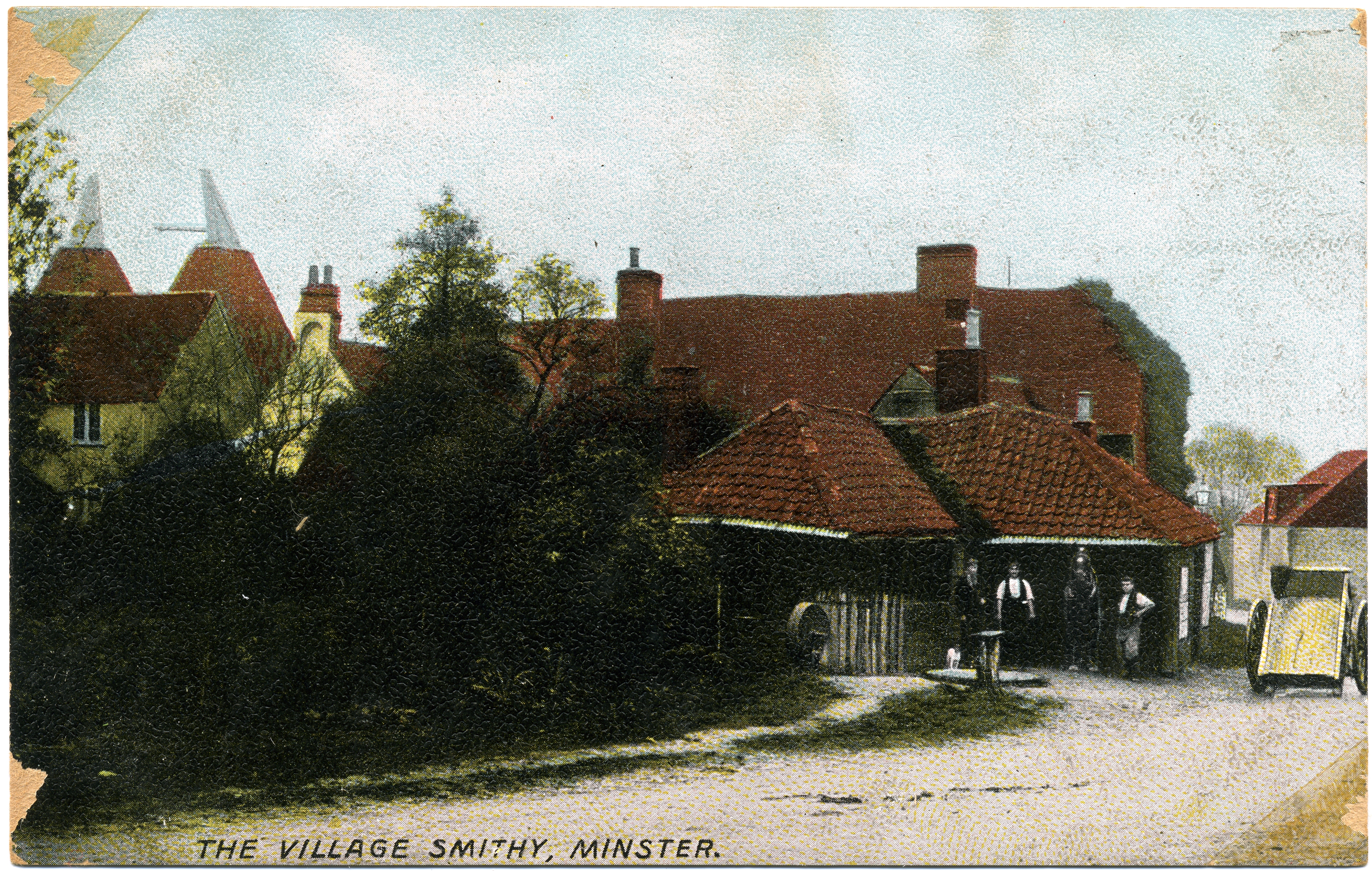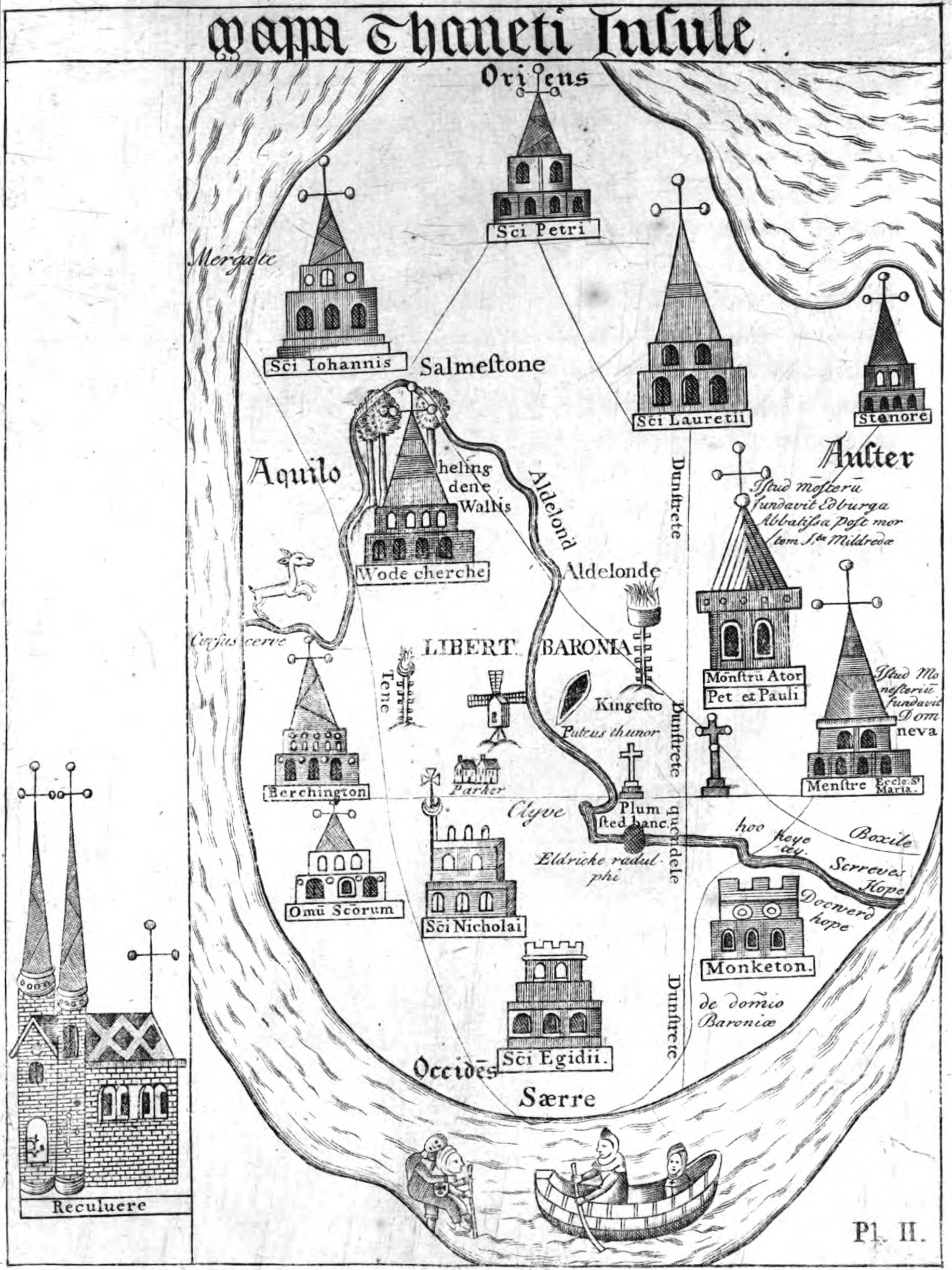|
Minster-in-Thanet
Minster, also known as Minster-in-Thanet, is a village and civil parish in the Thanet District of Kent, England. It is the site of Minster in Thanet Priory. The village is west of Ramsgate (which is the post town) and to the north east of Canterbury; it lies just south west of Manston Airport and just north of the River Stour. Minster is also the "ancient capital of Thanet".Minster-In-Thanet ; retrieved on 22 May 2008 At the 2011 Census the hamlet of Ebbsfleet was included. Toponymy The name ultimately comes from the ''monasterium'', denoting the histor ...[...More Info...] [...Related Items...] OR: [Wikipedia] [Google] [Baidu] [Amazon] |
Domneva
Domne Eafe (; floruit late 7th century), also ''Domneva'', ''Domne Éue'', ''Æbbe'', ''Ebba'', was, according to the Kentish royal legend, a granddaughter of King Eadbald of Kent and the foundress of the double monastery of Minster in Thanet Priory at Minster-in-Thanet during the reign of her cousin King Ecgberht of Kent. A 1000-year-old confusion with her sister Eormenburg means she is often now known by that name. Married to Merewalh of Mercia, she had at least four children. When her two brothers, Æthelred and Æthelberht, were murdered (and subsequently venerated as saintly martyrs) she obtained the land in Thanet to build an abbey, from a repentant King Ecgberht. Her three daughters all went on to become abbesses and saints, the most famous of which, Mildrith, ended up with a shrine in St Augustine's Abbey, Canterbury. Origins According to the Kentish royal legend, Domne Eafe's father was Eormenred, son of King Eadbald of Kent and Emma of Austrasia, and grandson of Æthelb ... [...More Info...] [...Related Items...] OR: [Wikipedia] [Google] [Baidu] [Amazon] |
Mildrith
Saint Mildrith, also Mildthryth, Mildryth and Mildred, () (born c. 660, died after 732), was a 7th- and 8th-century Anglo-Saxons, Anglo-Saxon abbess of the Abbey at Minster-in-Thanet, Kent. She was declared a saint after her death, and, in 1030, her remains were moved to Canterbury. Life and family Mildrith was the daughter of King Merewalh of Magonsaete, an area similar to the present day Herefordshire, a sub-kingdom of Mercia. Her mother was Domne Eafe (also sometimes named as Saint Eormenburga), herself a great-granddaughter of Æthelberht of Kent, and as such appearing in the so-called Kentish Royal Legend. Her sisters Mildburh, Milburga of Much Wenlock and Mildgytha, Mildgyth were also considered saints, and Mildrith, along with her extended family, features in the Kentish Royal Legend, also known as the "Mildrith Legend". In the 11th century, Goscelin wrote a hagiography of Mildrith, the ''Vita Mildrethae''.Rollason (1982) p. 16 Another work, the ''Nova Legenda Anglie'' of ... [...More Info...] [...Related Items...] OR: [Wikipedia] [Google] [Baidu] [Amazon] |
Minster In Thanet Priory
Minster Abbey is the name of two abbeys in Minster-in-Thanet, Kent, England. The first was a 7th-century foundation which lasted until the Dissolution of the Monasteries. Beside its ruins is St Mildred's Priory, a Benedictine community of women founded in 1937. History According to the Kentish Royal Legend, Minster Abbey was a double monastery founded AD 670 by Domne Eafe or Domneva; Eormenburg or Ermenburga is either her original name or that of her sister. Domne Eafe was a Kentish princess who accepted land for a house of prayer as Weregild for the killing of her brothers Æthelred and Æthelberht. The story is that she was granted as much land as her pet deer could define in a day, whence the deer used to symbolise Minster-in-Thanet. The boundary so defined is shown on mediaeval maps, and has been called the Cursus Cerve or St Mildred’s Lynch. Domne Eafe was succeeded as abbess in about 700 by her daughter Mildrith (Mildred), who was succeeded by Edburga, daughter of King ... [...More Info...] [...Related Items...] OR: [Wikipedia] [Google] [Baidu] [Amazon] |
Edburga Of Minster-in-Thanet
Saint Edburga of Minster-in-Thanet (also known as Eadburh and Bugga) was a princess of Wessex, and abbess of Minster-in-Thanet. She is regarded as a saint. Life Edburga was the only daughter of King Centwine and Queen Engyth of Wessex. According to Stephen of Ripon, Engyth was a sister of Queen Iurminburh, second wife of King Ecgfrith of Northumbria. Centwine was not a Christian, but towards the end of his reign, converted and became a monk. Edburga was a friend and student of Saint Mildrith, abbess of Minster-in-Thanet."Edburga (Eadburh, Bugga) of Minster", ''The Oxford Dictionary of Saints'' (5 rev) (David Farmer, ed.) OUP, 2011 She was reputed to be zealous in the pursuit of knowledge. In 716, Edburg ... [...More Info...] [...Related Items...] OR: [Wikipedia] [Google] [Baidu] [Amazon] |
Kentish Royal Legend
The Kentish Royal Legend is a diverse group of Medieval texts which describe a wide circle of members of the royal family of Kent from the 7th to 8th centuries AD. Key elements include the descendants of Æthelberht of Kent over the next four generations; the establishment of various monasteries, most notably Minster-in-Thanet; and the lives of a number of Anglo-Saxon saints and the subsequent travels of their relics. Although it is described as a legend, and contains a number of implausible episodes, it is placed in a well attested historical context. The legend Æthelberht and his descendants Almost all the accounts begin by describing how Æthelberht of Kent was baptised by Augustine. The fullest accounts (such as Bodley 285, see below) then provide a substantial genealogy, involving not only his direct descendants but also the families some of the daughters marry into, the kings of Northumbria, Mercia, and East Anglia. The family tree below is David Rollason's summary of the ... [...More Info...] [...Related Items...] OR: [Wikipedia] [Google] [Baidu] [Amazon] |
Centwine Of The West Saxons
Centwine (died after 685) was King of Wessex from c. 676 to 685 or 686, although he was perhaps not the only king of the West Saxons at the time. The ''Anglo-Saxon Chronicle'' reports that Centwine became king c. 676, succeeding Æscwine. Bede states that after the death of King Cenwalh: "his under-rulers took upon them the kingdom of the people, and dividing it among themselves, held it ten years". Bede's dismissal of Æscwine and Centwine as merely sub-kings may represent the views of the supporters of the King Ine, whose family ruled Wessex in Bede's time. However, if the West Saxon kingdom did fragment following Cenwalh's death, it appears that it was reunited during Centwine's reign. An entry under 682 in the ''Anglo-Saxon Chronicle'' records that "Centwine drove the Britons to the sea". This is the only event recorded in his reign. The ''Carmina Ecclesiastica'' of Aldhelm, Bishop of Sherborne (died 709), written a generation after Centwine's reign, records that he won t ... [...More Info...] [...Related Items...] OR: [Wikipedia] [Google] [Baidu] [Amazon] |
Manston Airport
Manston Airport is a British airport. Originally operated as RAF Manston, from 1916, it has also operated as a commercial airport and was known as Kent International Airport and, briefly, London Manston Airport. It has been closed since 2014. Located in the parish of Minster-in-Thanet and partly adjacent to the village of Manston, Kent, Manston in the Thanet District, Thanet district of Kent, England, north-east of Canterbury. The single runway is located about from the coastline at above sea level. It has the 11th-longest civilian runway in the United Kingdom (after Heathrow Airport, Heathrow's two runways, Gatwick Airport, Gatwick, Birmingham Airport, Birmingham, Manchester Airport, Manchester, London Stansted Airport, Stansted, East Midlands Airport, East Midlands, Doncaster Sheffield Airport, Doncaster, Glasgow Prestwick Airport, Prestwick and Belfast International Airport, Belfast International), in length. When operational, Manston was capable of handling some of t ... [...More Info...] [...Related Items...] OR: [Wikipedia] [Google] [Baidu] [Amazon] |
Ebbsfleet, Thanet
Ebbsfleet is a hamlet near Ramsgate, Kent, at the head of Pegwell Bay. Historically it was a peninsula on the southern coast of the Isle of Thanet, marking the eastern end of the Wantsum Channel that separated Thanet from the Kentish mainland. It is in the civil parish of Minster-in-Thanet. Pegwell Bay is a natural harbour on the part of the coast nearest to the Continent, and consequently, Ebbsfleet was the focus of three important arrivals in English history: Julius Caesar’s first invasion of England in 54 BC, then Hengist and Horsa in 449 AD, said to have led the Anglo-Saxons in their conquest of Britain; and lastly Augustine of Canterbury in 597 AD, who converted much of England to Christianity. Ebbsfleet is the titular see of the Bishop of Ebbsfleet, an provincial episcopal visitor, episcopal visitor for the Province of Canterbury. Geography Ebbsfleet Lane marks the line of the peninsula today. The Wantsum Channel silted up and was reclaimed in the 15th century; all t ... [...More Info...] [...Related Items...] OR: [Wikipedia] [Google] [Baidu] [Amazon] |
Jutes
The Jutes ( ) were one of the Germanic people, Germanic tribes who settled in Great Britain after the end of Roman rule in Britain, departure of the Roman Britain, Romans. According to Bede, they were one of the three most powerful Germanic nations, along with the Angles (tribe), Angles and the Saxons: There is no consensus amongst historians on the origins of the Jutes. One hypothesis is that they originated from the Jutland Peninsula but after a Danish invasion of that area, migrated to the Frisian coast. From the Frisian coast they went on to settle southern Britain in the later fifth century during the Migration Period, as part of a larger wave of Germanic migration into Britain. They were possibly or probably related to the North Germanic tribe Geats. Settlement in southern Britain During the period after the Roman Britain, Roman occupation and before the Norman conquest, people of Germanic descent arrived in Britain, ultimately forming England. The ''Anglo-Saxon Chr ... [...More Info...] [...Related Items...] OR: [Wikipedia] [Google] [Baidu] [Amazon] |
Augustine Of Canterbury
Augustine of Canterbury (early 6th century in England, 6th century – most likely 26 May 604) was a Christian monk who became the first archbishop of Canterbury in the year 597. He is considered the "Apostle to the English". Augustine was the Prior (ecclesiastical), prior of a monastery in Rome when Pope Pope Gregory I, Gregory the Great chose him in 595 to lead a mission, usually known as the Gregorian mission, to Britain to Christianization, Christianize King Æthelberht of Kent, Æthelberht and his Kingdom of Kent from Anglo-Saxon paganism. Kent was likely chosen because Æthelberht Bretwalda, commanded major influence over Heptarchy, neighbouring Anglo-Saxon kingdoms in addition to his marriage to Bertha of Kent, Bertha, a Franks, Frankish princess, who was expected to exert some influence over her husband. Before reaching Kent, the missionaries had considered turning back, but Gregory urged them on, and in 597, Augustine landed on the Isle of Thanet and proceeded t ... [...More Info...] [...Related Items...] OR: [Wikipedia] [Google] [Baidu] [Amazon] |
Bede
Bede (; ; 672/326 May 735), also known as Saint Bede, Bede of Jarrow, the Venerable Bede, and Bede the Venerable (), was an English monk, author and scholar. He was one of the most known writers during the Early Middle Ages, and his most famous work, '' Ecclesiastical History of the English People'', gained him the title "The Father of English History". He served at the monastery of St Peter and its companion monastery of St Paul in the Kingdom of Northumbria of the Angles. Born on lands belonging to the twin monastery of Monkwearmouth–Jarrow in present-day Tyne and Wear, England, Bede was sent to Monkwearmouth at the age of seven and later joined Abbot Ceolfrith at Jarrow. Both of them survived a plague that struck in 686 and killed the majority of the population there. While Bede spent most of his life in the monastery, he travelled to several abbeys and monasteries across the British Isles, even visiting the archbishop of York and King Ceolwulf of Northumbria. ... [...More Info...] [...Related Items...] OR: [Wikipedia] [Google] [Baidu] [Amazon] |


